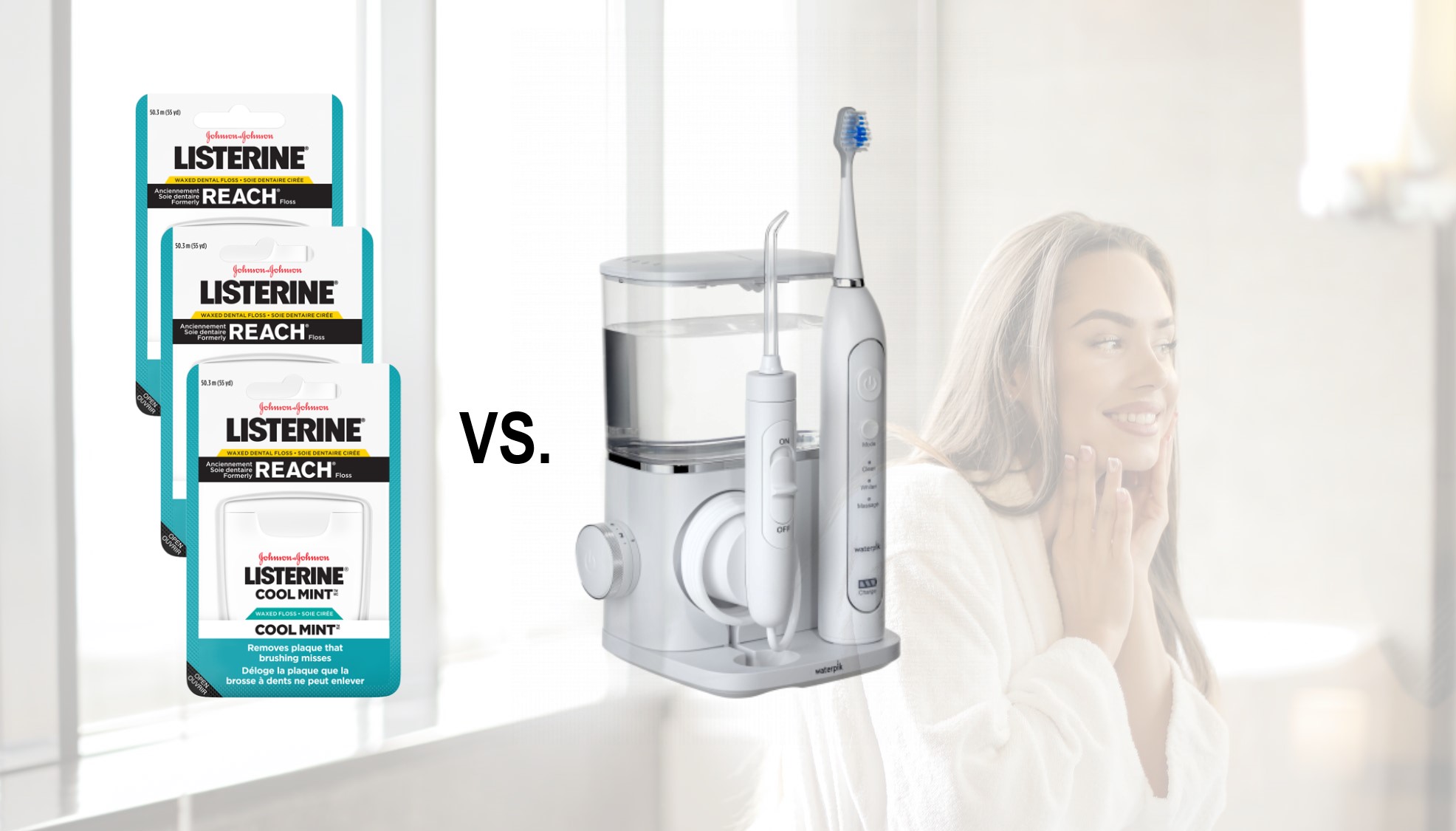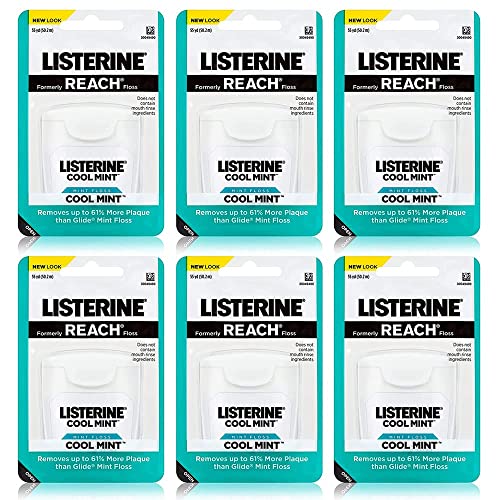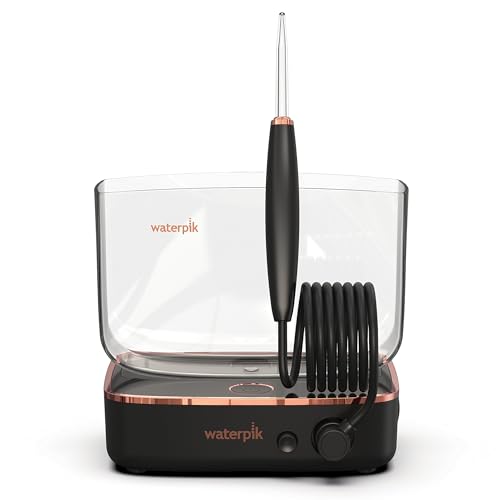Bad oral hygiene is the leading cause of tooth loss, gum disease, cavities, and other dental health issues. As days and weeks pass by, gum disease can affect your heart’s health. Apart from that, the bacteria responsible for gum disease can also move into your bloodstream, troubling the fetus.
While brushing your teeth twice daily can prevent these problems, it may not be enough. Frankly, toothbrush bristles aren’t small enough to clean the tight spaces between the teeth, thus leaving food particles and harmful bacteria behind.
Thankfully, you can significantly boost your oral care by turning to interdental cleaning like flossing. It helps to remove bacteria, plaque, and food particles between the teeth.
For interdental cleaning, you can decide to go with a Waterpik water flosser or dental floss. If you’re not sure about which option to go for, we will compare the two options – Waterpik vs Flossing – and help you understand the similarities and difference, so that you can make the right choice.
All medical content on this site, including this guide and other product reviews, is written by our team of experienced writers and researchers. All writers from The Toothbrush Expert are recommended and reviewed in the industry. You support us through our editorially chosen links, which earn us commission. learn more
All of our picks have the American Dental Association (ADA) Seal of Acceptance.
What are Waterpik Water Flossers?
A dentist from Colorado in the United States of America (USA) invented the first oral irrigator in 1962. The inventor’s goal was to provide an oral care solution that perfectly complements brushing. For years, the invention has not disappointed. Moreover, it gave birth to a reliable product like the Waterpik Water Flosser.
Waterpik water flossers – also known as oral pulsating irrigators or dental water jets – utilize a pressurized flow of pulsating water to get rid of plaque, bacteria, and food particles under the gum line and between the teeth. They even help to reduce gum disease and bleeding.
We must note that Waterpik is not a substitute for brushing, the former only complements the latter. Flossing doesn’t remove visible film and plaque on your teeth as brushing does.
You may choose Waterpik over flossing if you;
- Have crowns
- Have non-removable bridgework
- Wear braces
- Have dental implants
If you have arthritis or you struggle to use string floss, you may also find a Waterpik easier to use.
As a new user, if you want the device to deliver optimum performance, you should place the flosser tip in your mouth before you switch on the unit. Also, you should move the tip slowly and glide it along your gum line softly.
For the most effective results, you should start with the back teeth and move forward to the front teeth. Continue moving the tip until you’ve treated both the inside and outside of the lower and upper teeth. This action guarantees total and thorough cleaning of the mouth.
With Waterpik flossers, you shouldn’t worry about your safety because it offers no risk.
Pros of Waterpik Water Flossers
- Treat hard-to-reach places in the mouth
- Help to keep breath fresher for a longer period
- Simple to use
Cons of Waterpik Water Flossers
- Rinsing action may not be enough to remove plaque from the teeth surface.
- May be messy as a result of excessive water
- More expensive than dental floss
















What is Traditional Dental Floss?
Dental floss is the oldest form of interdental cleaning. A dentist called Levi Spear Parmly first recommended dental flossing in his book ‘A Practical Guide to the Management of the Teeth’ in 1819. However, the idea wasn’t patented until 55 years later by Asahel Shurtleff. At the time, the packaging included a cutter.
In the 1800s, floss was made out of unwaxed silk. However, the oral care method was not popular until after World War II. By that time, nylon was being used for floss instead of silk.
Today, floss is generally sold pre-cut in plastic holders known as dental picks. You get to cut your preferred length from long strands. You can find traditional dental floss in flavored models and as unwaxed or waxed strands.
Pros of Dental Floss
- Removes plaque, food particles, and particles bacteria from beneath the teeth
- Allows to clean each tooth and remove sticky plaque before tartar is developed.
- Gives the user significant control
- Manual flossing allows to clean each of the teeth in an up-and-down motion
Cons of Dental Floss
- Doesn’t allow people with dental work to treat certain parts of the mouth
- Hard to reach between that stay very close together
- Flossing too hard may cause gums to bleed
A quick overview of the best dental floss products on the market:
Are Water Flossers Really More Effective Than Floss?
When it comes to dental hygiene, you want a method you can enjoy and easily practice everyday for the best results. While some people like the control they get from manual flossing, others prefer the gentle, deep-clean, and fresh feeling they get after flossing with a Waterpik.
According to research, there is only a minimal difference in plaque removal between using a Waterpik and traditional floss.
The fact is: both string floss and Waterpik water flossers are very effective in cleaning the teeth and gums, complementing brushing. Despite this fact, we advise that you speak to your dentist about these options, so you can get the right and professional advice to choose the better option for your oral health.
Besides, the widely recognized American Dental Association (ADA) recommends brushing twice daily and flossing once a day to clean between the teeth.
Do Dentists Recommend Water Flossing?
Yes, dentists recommend water flossing due to its effectiveness and ease of use. However, many dentists still advise patients to use a Waterpik flosser alongside dental floss as a complementary means to clean the mouth thoroughly.
How Much Do Water Flossers Cost Compared to Floss?
Water flossers cost much higher than traditional floss. That’s quite understandable considering the many automatic features water flossers offer.
Waterpik flossers’ prices range from $50 to $120 depending on the model you choose to purchase. On the other hand, string floss typically costs a few dollars, but a water flosser your can use for years and a string floss you have to buy every few weeks. It depends how many times you use the product.
Types of Water Flossers
There are three different kind of water flossers:
- Cordless water flossers it is in the name they are portable and easy to carry when traveling around.
- Electric toothbrush and water flosser combination it is again in the name it is a combination of an electric toothbrush and a water flosser in one product. They are becoming more and more popular the last couple of years.
- Water flosser the normal water flosser as we know the product from the beginning.
Best Water Flossers
Waterpik is the leading water flosser brand among dentists and other oral health professionals. Thanks to the brand’s several devices for different needs, it’s no surprise that it is the most recommended by dental professionals.
Aquarius® Professional Water Flosser
The Aquarius Professional Water Flosser is a top Waterpik model. It boasts a compact design as well as ease of use. The product’s Floss Mode uses pulse-modulation technology to remove plaque. Thanks to the Hydro-Pulse Mode, this flosser also offers gum stimulation to improve circulation.
The model also features a one-minute timer with a 30-second pacer to help achieve thorough and complete flossing of all areas of your mouth. The handle features an on/off button. The flosser comes in a variety of colors.
Tip!
Complete product review: Waterpik 660
Radiant Orchid Ultra Water Flosser
This Ultra Water Flosser is another model of Waterpik. It features a storage space for extra lids and a water-pause button on its handle. This model’s effectiveness is confirmed by the acceptance of the American Dental Association (ADA).
Apart from the flosser, the package comes with 2 Classic Jet Tips (general cleaning). 1 Orthodontic Tip (people with dental work), 1 Plaque Seeker Tip (plaque removal), Rapid Magnetic Charger, Tip Storage Case, and a Microfiber Travel Bag.
Sidekick® Water Flosser, White with Chrome
The Sidekick® Water Flosser is an ultra-compact Waterpik model. It boasts the same patented Waterpik technology used in full-sized and countertop units. This model is ideal for storing in small spaces. With the premium water-resistant storage travel, this flosser is also built for traveling.
Conclusion
While brushing is very important, flossing is regarded as a worthy complement. Dentists recommend that both dental care methods are used regularly for the best results. When it comes to interdental cleaning, it’s usually Waterpik vs Flossing. You can decide to go with a water flosser or the traditional string floss. Ultimately, you should make a choice based on your preference, need, and dentist’s advice.
References
Is it more effective to floss teeth with a water pick or standard dental floss?, Mayo Clinic, February 2020, https://www.mayoclinic.org/healthy-lifestyle/adult-health/expert-answers/dental-floss/faq-20058112#:~:text=A%20water%20pick%20can%20help,bacteria%20even%20below%20the%20gumline
Mazhari, Fatemeh et al. “The effect of toothbrushing and flossing sequence on interdental plaque reduction and fluoride retention: A randomized controlled clinical trial.” Journal of periodontology vol. 89,7 (2018): 824-832, https://pubmed.ncbi.nlm.nih.gov/29741239/
Lyle, Deborah M. “Relevance of the water flosser: 50 years of data.” Compendium of continuing education in dentistry (Jamesburg, N.J. : 1995) vol. 33,4 (2012): 278-80, 282, https://pubmed.ncbi.nlm.nih.gov/22536661/
Goyal, C Ram et al. “Evaluation of the plaque removal efficacy of a water flosser compared to string floss in adults after a single use.” The Journal of clinical dentistry vol. 24,2 (2013): 37-42, https://pubmed.ncbi.nlm.nih.gov/24282867/
Lyle, Deborah M et al. “Efficacy of the Use of a Water Flosser in Addition to an Electric Toothbrush on Clinical Signs of Inflammation: 4-Week Randomized Controlled Trial.” Compendium of continuing education in dentistry (Jamesburg, N.J. : 1995) vol. 41,3 (2020): 170-177, https://pubmed.ncbi.nlm.nih.gov/31904246/
Countertop Water Flosser, Waterpik, https://www.waterpik.com/oral-health/products/dental-water-flosser/


Dr Michael Jones is the proud founder of The Toothbrush Expert. He has been working as a dentist for 21 years now. Besides his work as a dentist, Michael wants to help people to find the right dental products. His goal is to provide everyone with honest expert reviews on all kinds of dental care products.










